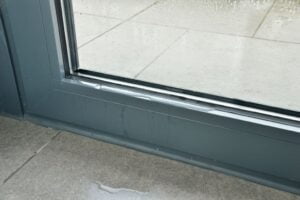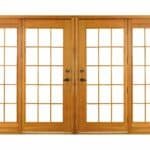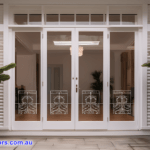 French doors can leak due to various causes, such as deteriorated weatherstripping, improper installation or strong winds pushing against them. If your home has a set of these stylish yet resilient double-door units which are starting to leak, it’s important to take appropriate action as soon as possible in order to avoid costly repairs down the line. In this guide, we will examine why your French doors may have started releasing moisture into the interior spaces and provide you with effective advice for preventing future leaks from taking place.
French doors can leak due to various causes, such as deteriorated weatherstripping, improper installation or strong winds pushing against them. If your home has a set of these stylish yet resilient double-door units which are starting to leak, it’s important to take appropriate action as soon as possible in order to avoid costly repairs down the line. In this guide, we will examine why your French doors may have started releasing moisture into the interior spaces and provide you with effective advice for preventing future leaks from taking place.
Quick tips:
- Check the seals around the door frame for any gaps or damage
- Check if there is a buildup of dirt or debris between the doors
- Check if the threshold is level, if not, use a spirit level to adjust
- Check the weatherstripping for signs of wear and tear
- Check if the window frames and sills are properly sealed
- Inspect the drain holes at the bottom of the doors
- Check for any loose screws or nails
- Ensure the doors are properly aligned with the opening
- Apply sealant around the edges if necessary
(adsbygoogle=window.adsbygoogle||[]).push({})
Table of Contents
French door leaking around the glass?
French door leaks around the glass are a common issue among many homeowners. This type of leak problem is often caused by improper installation, poor seals or inadequate weatherproofing on your French doors. Even when sealed properly and maintained regularly, air can still be difficult to escape from between the frames and panes due to their unique design structure – which in turn leaves you liable for costly damage repairs if not addressed quickly!
Fortunately, one can take several simple yet effective measures to ensure that these pesky issues are manageable.
Quick tips:
- Check for visible signs of damage on the frame, seals and gaskets.
- Inspect all weatherstripping around the glass to ensure that it is intact and free from holes or tears which could allow water in.
- Replace any faulty components, such as age-deteriorated glazing compound or caulk around the window opening to prevent future leaks.
- If necessary, install additional flashings strips at penetration points where air/water can quickly enter through seams between sash elements & corresponding frames.
- Utilize a silicone sealant along your perimeter windows posts & casements instead of an elastomeric joint tape (Sealants will remain permanently flexible).
French doors leaking when it rains?
French doors leaking when heavy rains is a common problem, but not one without solutions. The first step in resolving the issue is to properly inspect and identify any areas of concern that may be causing water ingress into your home or property. Areas such as seals around door frames, windowpanes, and weatherstripping on locksets and thresholds should all be inspected for damage or wear-and-tear, which could cause rainwater leaks.
Other factors, such as poor installation technique, can also lead to French door leakage during rainy periods – ensuring that the installer followed correct sealing instructions will help determine if this was an issue with their workmanship.
Quick tips:
- Inspect external trim seals around windows & doors regularly for signs of deterioration.
- Check that interior/exterior caulking surrounding frame joints are fully intact.
- Ensure threshold sealant has been applied correctly at the bottom edge.
- Make sure manufacturer guidelines have installed perimeter insulation boards.
- Look for gaps between sections where two leaves meet – fill using foam backer rod & caulk.
(adsbygoogle=window.adsbygoogle||[]).push({})
French door leaking around the glass?
When a French door leaks around the glass, it could be due to improper installation or damaged weather seals. To identify the issue accurately and determine a practical solution, inspect the interior and exterior components for signs of wear, such as loose screws, peeling paint/sealant along seams between panels, compromised window panes, etc. If any are found that may have caused leakage in the first place, adequately address them before attempting further repairs; if not, resealing with fresh sealants should fix the problem quickly without replacing parts altogether.
Make sure all edges surrounding windows are sealed correctly using caulk or clear silicone adhesive so when rain falls, they don’t seep through, causing damage over time – this will also help maintain energy efficiency inside your home.
Why are my French doors not sealing properly?
Your French doors may need to be sealed correctly if the weatherstripping is damaged, improperly installed or worn down over time. Weatherstripping helps create an airtight seal between two surfaces. It prevents water leaks by filling any gaps caused by the expansion/contraction of material due to temperature changes. Suppose these strips are torn, old or missing altogether. In that case, it will cause a break in the barrier allowing warm air out during winter months and cool air to escape during summertime, which can lead to drafty rooms with high energy bills.
For best results, consider replacing your door’s existing weatherstripping with modern options that include top-of-the-line compression technology for superior performance year round as well as improved aesthetics for enhanced curb appeal value on your property.
(adsbygoogle=window.adsbygoogle||[]).push({})
How to prevent French doors from leaking?
 One of the most effective ways to prevent French doors from leaking is by ensuring that all components used in their installation are designed for outdoor use. This includes door frames, seals, and hinges should be made from material such as PVC or aluminium rather than wood, which can easily succumb to moisture damage over time. It’s also important to ensure a proper seal between each frame section; this may involve using weatherstripping tape and high-quality silicone caulk around the edges where the two pieces meet.
One of the most effective ways to prevent French doors from leaking is by ensuring that all components used in their installation are designed for outdoor use. This includes door frames, seals, and hinges should be made from material such as PVC or aluminium rather than wood, which can easily succumb to moisture damage over time. It’s also important to ensure a proper seal between each frame section; this may involve using weatherstripping tape and high-quality silicone caulk around the edges where the two pieces meet.
Additionally, check regularly for any signs of wear on exterior surfaces like paint chips – these need immediate repair to maintain an airtight edge and preserve energy efficiency levels inside your home or office space. Finally, it’s vitally important when installing external grade screws through exposed parts of wooden framing – to make sure you choose corrosion-resistant materials, so they don’t degrade quickly due to wind-driven rain exposure.
1. Check the door seals – Inspect if your French doors have adequate sealant to prevent air and water from entering the space between them. Look for any signs of damage or wear to replace as needed.
2. Install weather stripping around each side of the frame – Weather stripping is adhesive-backed foam insulation strips that should be placed on both sides in order to keep out drafts, wind, rain and other elements when closed.
3. Use a top sweep – A top sweep attaches onto either one or both patio doors at its base by screws, creating an extra barrier against dirt, dust particles and moisture coming through gaps.
4. Invest in threshold gaskets – Gaskets are usually made with rubber specifically designed for this purpose; apply along all four edges where two panels meet together.
How To Stop Water Coming In Under French Doors?
Sealing the bottom of French doors is an important step in maintaining their functionality and aesthetic appeal. It not only keeps out drafts and improves energy efficiency, but also helps protect against water damage from rain and snow entering through small gaps at the base of your door frame or between panels.
The best way to seal a French door’s lower edge is by using a combination of weatherstripping, caulk or silicone-based adhesives, and thresholds installed on top for additional protection. Weatherstrip can be applied around all four sides where two leaves meet as well as any areas that may have been missed when initially installing them; these strips come in various shapes, sizes and materials suitable for different types of French doors, so it’s important to choose one appropriate for your specific application before installation begins.
Caulk should then be used liberally around each side panel joint while ensuring no air leakage occurs, which could cause condensation issues over time; sealing this area properly will help ensure long-term performance benefits too!
Finally, threshold seals need to go down inside AND outside surfaces – use pre-cut lengths according to manufacturer instructions included within most kits sold today – they provide extra insulation and serve as another layer protecting against moisture penetration below grade-level floors such as basements.
Combined, these steps ensure your French doors stay secure and effective against the elements while adding a beautiful finishing touch to any home.
Quick Tips for Sealing French Doors:
1. Apply weatherstrip around all four sides where two leaves meet and any missed areas when initially installing the doors.
2. Use caulk liberally on each side panel joint to ensure no air leakage occurs over time, which could lead to condensation issues later down the line.
3. Install threshold seals inside and outside surfaces – use pre-cut lengths according to manufacturer instructions included with most kits today – they provide extra insulation and serve as another layer protecting against moisture penetration below grade level floors such as basements.
(adsbygoogle=window.adsbygoogle||[]).push({})
How do you waterproof French doors?
Waterproofing French doors are important when installing them, as it helps protect against extreme weather and moisture damage. To ensure your door remains in good condition over time, you can take a few simple steps to waterproof the area around the frame. First, apply sealant or caulk on both sides of the opening where air could pass through; this will prevent water from seeping into any gaps between wall sections or window frames.
Additionally, use silicone-based caulking inside corners and joints for additional protection if needed.
Finally, add weatherstripping along edges that may be exposed to rainwater – like top thresholds – which should help keep out moisture whilst also allowing smooth operation of hinges etc.
Following these steps will provide effective waterproofing for your French doors so they stay great despite wet outside conditions!
Quick advice:
– Apply sealant or caulk on both sides of the opening where air could pass through.
– Use silicone-based caulking inside corners and joints for additional protection if needed.
– Add weather stripping along edges that may be exposed to rainwater, like top thresholds.
– Follow these steps carefully to provide effective waterproofing for your French doors.
What is the best material to use to seal French doors?
 The best material to use for sealing French doors is a silicone-based caulk. It provides superior adhesion and flexibility, making it the ideal option when dealing with temperature changes or expanding/contracting materials like wood frames and glass panes. Silicone also offers excellent water resistance that can help prevent the warping of components over time due to moisture seeping in through cracks between panels.
The best material to use for sealing French doors is a silicone-based caulk. It provides superior adhesion and flexibility, making it the ideal option when dealing with temperature changes or expanding/contracting materials like wood frames and glass panes. Silicone also offers excellent water resistance that can help prevent the warping of components over time due to moisture seeping in through cracks between panels.
Furthermore, this type of caulking degrades more slowly than other options, such as vinyl strips, so you will get a longer-lasting seal around your door frame, which prevents drafts from entering your home more effectively than alternatives on the market today.
(adsbygoogle=window.adsbygoogle||[]).push({})
Are there any special considerations for French doors in windy areas?
When considering the installation of French doors in windy areas, it is important to take into account several factors.
Firstly, selecting materials that are resistant to strong winds and driving rain should be a priority; look for high-quality hardwood or composite options with sturdy frames and reinforced glass panes where possible.
Secondly, installing protective seals around window edges can provide additional protection against drafts coming through gaps between sashes – this will help maintain comfortable temperatures within your property year-round while also preserving energy efficiency levels throughout all seasons.
Lastly, ensuring proper anchoring systems are installed during fitting can ensure safe operation even under heavy gusts – these typically involve fixing door hinges securely onto walls and adding stone thresholds at ground level, which create an effective barrier from outside elements entering interior spaces.
French door tips:
1. Selecting materials that are resistant to strong winds and driving rain.
2. Installing protective seals around window edges.
3. Ensuring proper anchoring systems are installed during fitting.
4. Fixing door hinges securely onto walls.
5. Adding stone thresholds at ground level.
What is the most effective way of insulating French doors?
The most effective way to insulate French doors is to choose energy-efficient materials and ensure that the frame around the door has a tight seal. Insulated glass, such as double- or triple-paned windows with Low Emissivity (Low E) coating, will help keep heat in during winter months while also blocking some ultraviolet rays from entering your home.
Weatherstripping can be used along any seams between the frames of both sides of each panel, creating an airtight barrier against drafts and moisture infiltration.
Finally, adding foam insulation panels inside hollow core doors helps further reduce sound transfer through gaps and increase thermal efficiency overall when combined with other methods mentioned above.
The bottom line is that if your French doors are leaking, it could be due to a variety of factors. From holes in the door frame or seals, improper installation and maintenance, to poor material selection – all these can lead to infiltration of moisture through the gaps between them and ultimately result in water damage over time.
Investing some effort into investigating potential leaks as soon as they arise would pay off significantly down–the–road by helping you avoid costly repairs caused by prolonged exposure from rainwater seepage inside your home‘s interior walls.
With an experienced professional who has expertise on this topic at hand such problems have much greater chances for being quickly identified and rectified with minimum discomfort thus providing peace of mind knowing that any current or future issues will be dealt promptly according to industry standards.
(adsbygoogle=window.adsbygoogle||[]).push({})
Related Articles:

Should french doors have a gap in the middle
When it concerns French-style doors, it’s essential to ensure adequate space between the door frames to enable them to operate smoothly. Door installers typically aim for a gap of 3mm to 5mm in thickness, as anything exceeding 5mm will appear unsightly and could cause…

Why Do French Doors Have The Knob In The Middle
French doors with knobs set in the centre are a signature feature of traditional European homes. This specific design is thought to have originated from door latches that predated the invention of door knobs. The knob at the door’s midpoint provides more security,…

Can You Get Fly Screens In French Doors?
Yes, it is true! Retractable fly screens are the most sought-after option for French doors due to their discreet design that does not compromise the door’s aesthetic appeal. These screens provide reliable protection against insects and allow for proper home…

How Long Does It Take To Install Exterior French Doors?
It typically takes between 4-7 hours to properly install exterior French Doors, depending on the complexity of the project and any potential issues that may arise during installation. With a comprehensive understanding of all aspects related to installing this door…

Can You Change The Opening Door On French Doors?
Yes, it is possible to change the opening direction of French doors. However, the task involves more than just reversing the door. The frame must be removed and reversed to accommodate the new opening direction, which requires remortising the hinges to face the other…

Can French doors be soundproof?
Yes, French doors can be soundproof. It’s a matter of selecting the right materials, insulation systems, and hardware to create an airtight seal and reduce noise transmission. For instance, solid core door slabs with compression seals around windows and entry/exit…

Are French Doors Better Than Sliding Patio Doors?
Are French Doors Better Than Sliding Patio Doors? It depends on your specific needs when it comes to deciding between French and sliding patio doors. Sliding patio doors are typically more energy-efficient, as they use insulated glass packs and frames. However, French…

French Door Options: Which One is Right for You?
French Door Options: Which One is Right for You? French doors have been growing in popularity for home improvement projects. Their allure lies in their exquisite design and the ability to let light filter into a space more cleanly than other door types, contributing…
Message Us
Get In touch below. Ask Any Question or Start a Free Quote
Call Us
1800 491 492









